FIN 6406: Financial Statement Analysis and Valuation of Lenovo
VerifiedAdded on 2023/01/16
|14
|3189
|71
Project
AI Summary
This project offers a comprehensive financial analysis of Lenovo Group Limited, examining its performance from 2014 to 2017. It begins with an overview of the company and its global operations. The analysis includes a detailed examination of financial ratios, comparing Lenovo's performance to industry averages across liquidity, solvency, asset management, and profitability metrics. The project delves into financial planning and analysis, evaluating trends and identifying strengths and weaknesses. Valuation techniques are applied, including pricing with comparables, the Capital Asset Pricing Model (CAPM) to determine the expected return, and the Weighted Average Cost of Capital (WACC). The firm's value is estimated using free cash flow analysis, incorporating a two-stage model to project future cash flows. The project concludes with recommendations based on the analysis, highlighting Lenovo's financial health and investment potential.
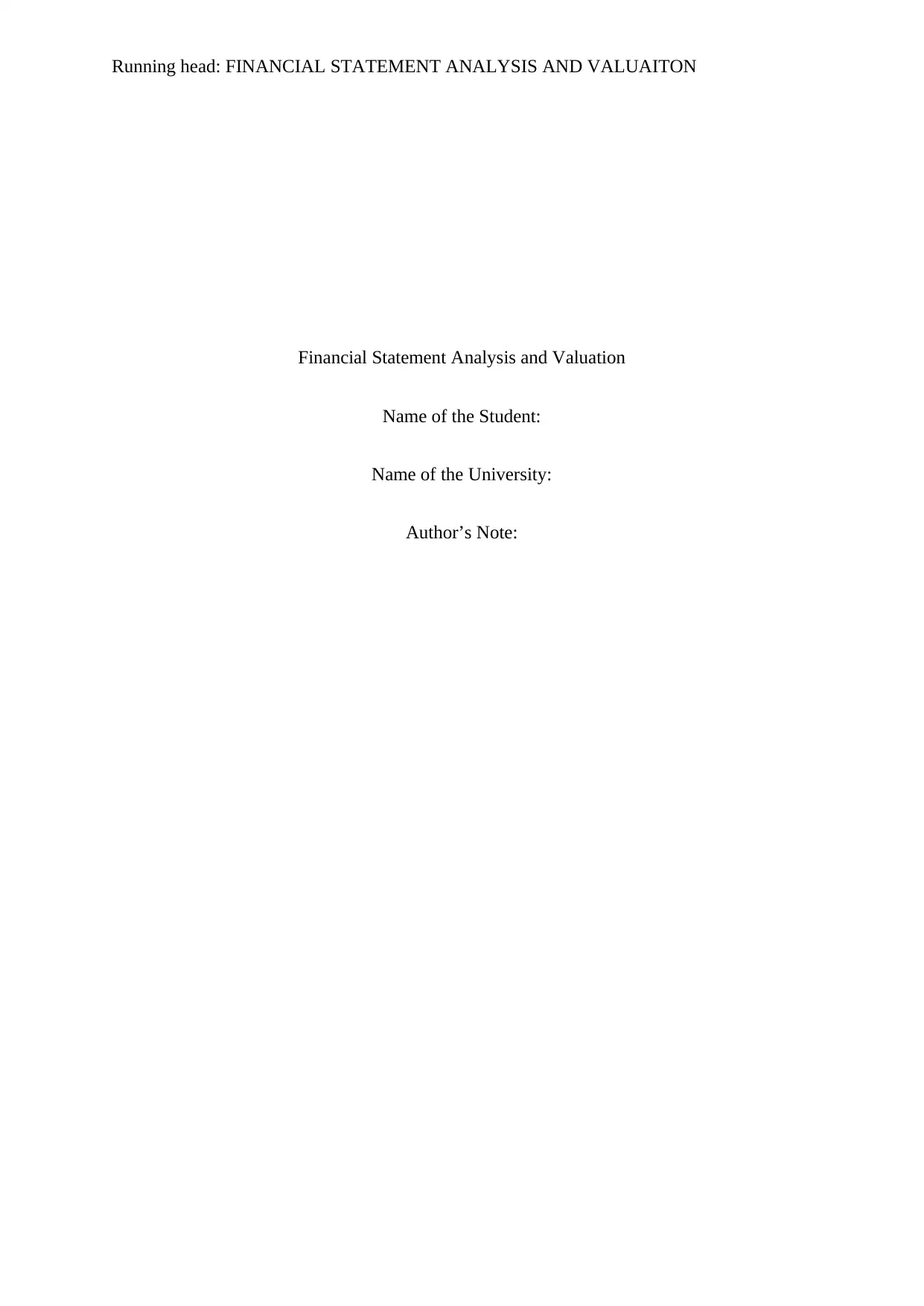
Running head: FINANCIAL STATEMENT ANALYSIS AND VALUAITON
Financial Statement Analysis and Valuation
Name of the Student:
Name of the University:
Author’s Note:
Financial Statement Analysis and Valuation
Name of the Student:
Name of the University:
Author’s Note:
Paraphrase This Document
Need a fresh take? Get an instant paraphrase of this document with our AI Paraphraser

1FINANCIAL STATEMENT ANALYSIS AND VALUATION
Table of Contents
Part 1: The Company:................................................................................................................2
Part 2: Financial Planning & Analysis:......................................................................................2
Sub part 1:..............................................................................................................................2
Sub part 2:..............................................................................................................................4
Sub part 3:..............................................................................................................................5
Part 3: Pricing with Comparables..............................................................................................6
Sub part 1:..............................................................................................................................6
Sub part 2:..............................................................................................................................6
Part 4: Capital Asset Pricing Model:..........................................................................................6
Part 5: Weighted Average Cost of Capital:................................................................................7
Part 6: Estimating Firm Value:..................................................................................................8
Par 7: Strengths, Weaknesses and recommendations:...............................................................9
References and bibliography:...................................................................................................11
Table of Contents
Part 1: The Company:................................................................................................................2
Part 2: Financial Planning & Analysis:......................................................................................2
Sub part 1:..............................................................................................................................2
Sub part 2:..............................................................................................................................4
Sub part 3:..............................................................................................................................5
Part 3: Pricing with Comparables..............................................................................................6
Sub part 1:..............................................................................................................................6
Sub part 2:..............................................................................................................................6
Part 4: Capital Asset Pricing Model:..........................................................................................6
Part 5: Weighted Average Cost of Capital:................................................................................7
Part 6: Estimating Firm Value:..................................................................................................8
Par 7: Strengths, Weaknesses and recommendations:...............................................................9
References and bibliography:...................................................................................................11
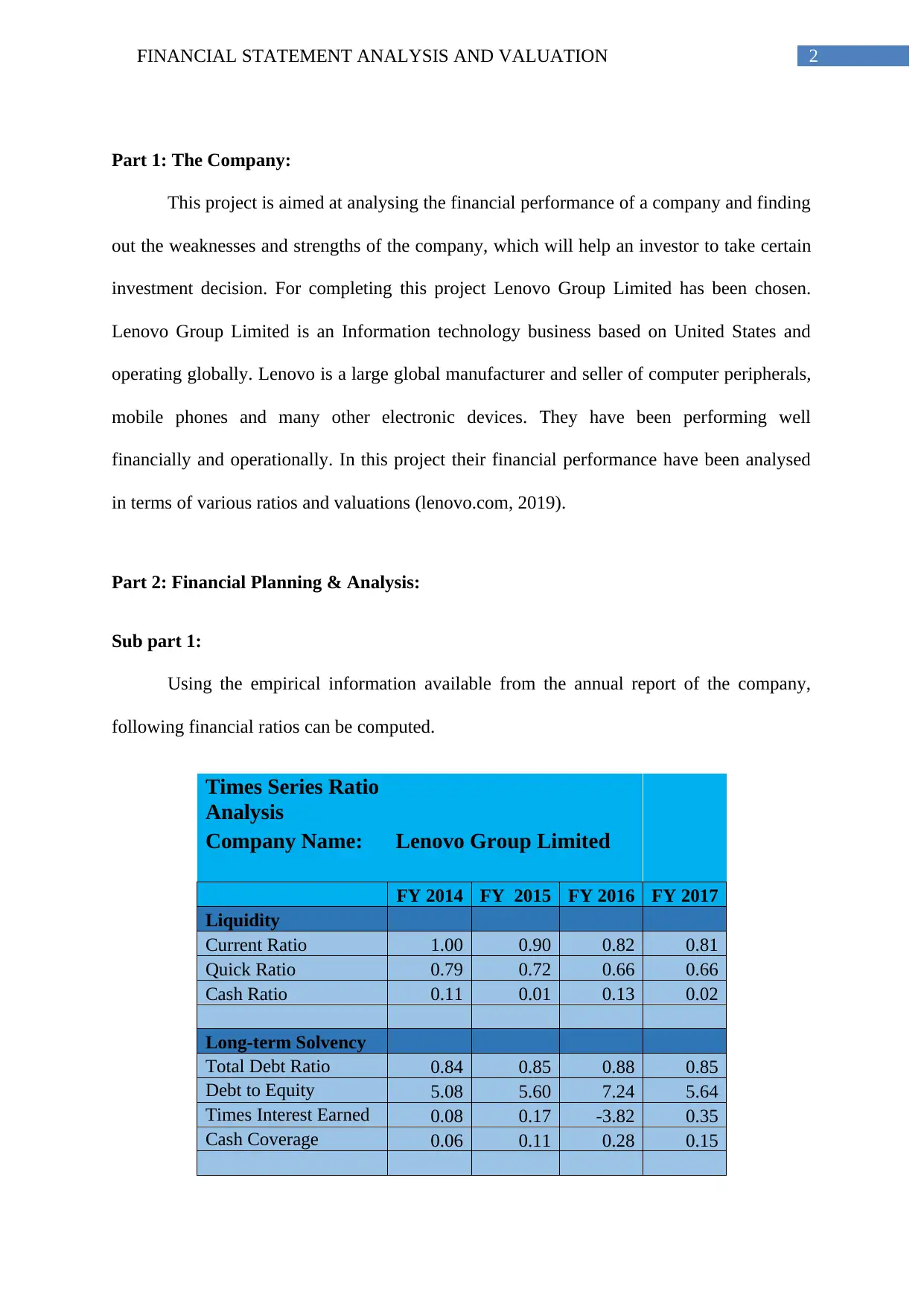
2FINANCIAL STATEMENT ANALYSIS AND VALUATION
Part 1: The Company:
This project is aimed at analysing the financial performance of a company and finding
out the weaknesses and strengths of the company, which will help an investor to take certain
investment decision. For completing this project Lenovo Group Limited has been chosen.
Lenovo Group Limited is an Information technology business based on United States and
operating globally. Lenovo is a large global manufacturer and seller of computer peripherals,
mobile phones and many other electronic devices. They have been performing well
financially and operationally. In this project their financial performance have been analysed
in terms of various ratios and valuations (lenovo.com, 2019).
Part 2: Financial Planning & Analysis:
Sub part 1:
Using the empirical information available from the annual report of the company,
following financial ratios can be computed.
Times Series Ratio
Analysis
Company Name: Lenovo Group Limited
FY 2014 FY 2015 FY 2016 FY 2017
Liquidity
Current Ratio 1.00 0.90 0.82 0.81
Quick Ratio 0.79 0.72 0.66 0.66
Cash Ratio 0.11 0.01 0.13 0.02
Long-term Solvency
Total Debt Ratio 0.84 0.85 0.88 0.85
Debt to Equity 5.08 5.60 7.24 5.64
Times Interest Earned 0.08 0.17 -3.82 0.35
Cash Coverage 0.06 0.11 0.28 0.15
Part 1: The Company:
This project is aimed at analysing the financial performance of a company and finding
out the weaknesses and strengths of the company, which will help an investor to take certain
investment decision. For completing this project Lenovo Group Limited has been chosen.
Lenovo Group Limited is an Information technology business based on United States and
operating globally. Lenovo is a large global manufacturer and seller of computer peripherals,
mobile phones and many other electronic devices. They have been performing well
financially and operationally. In this project their financial performance have been analysed
in terms of various ratios and valuations (lenovo.com, 2019).
Part 2: Financial Planning & Analysis:
Sub part 1:
Using the empirical information available from the annual report of the company,
following financial ratios can be computed.
Times Series Ratio
Analysis
Company Name: Lenovo Group Limited
FY 2014 FY 2015 FY 2016 FY 2017
Liquidity
Current Ratio 1.00 0.90 0.82 0.81
Quick Ratio 0.79 0.72 0.66 0.66
Cash Ratio 0.11 0.01 0.13 0.02
Long-term Solvency
Total Debt Ratio 0.84 0.85 0.88 0.85
Debt to Equity 5.08 5.60 7.24 5.64
Times Interest Earned 0.08 0.17 -3.82 0.35
Cash Coverage 0.06 0.11 0.28 0.15
⊘ This is a preview!⊘
Do you want full access?
Subscribe today to unlock all pages.

Trusted by 1+ million students worldwide
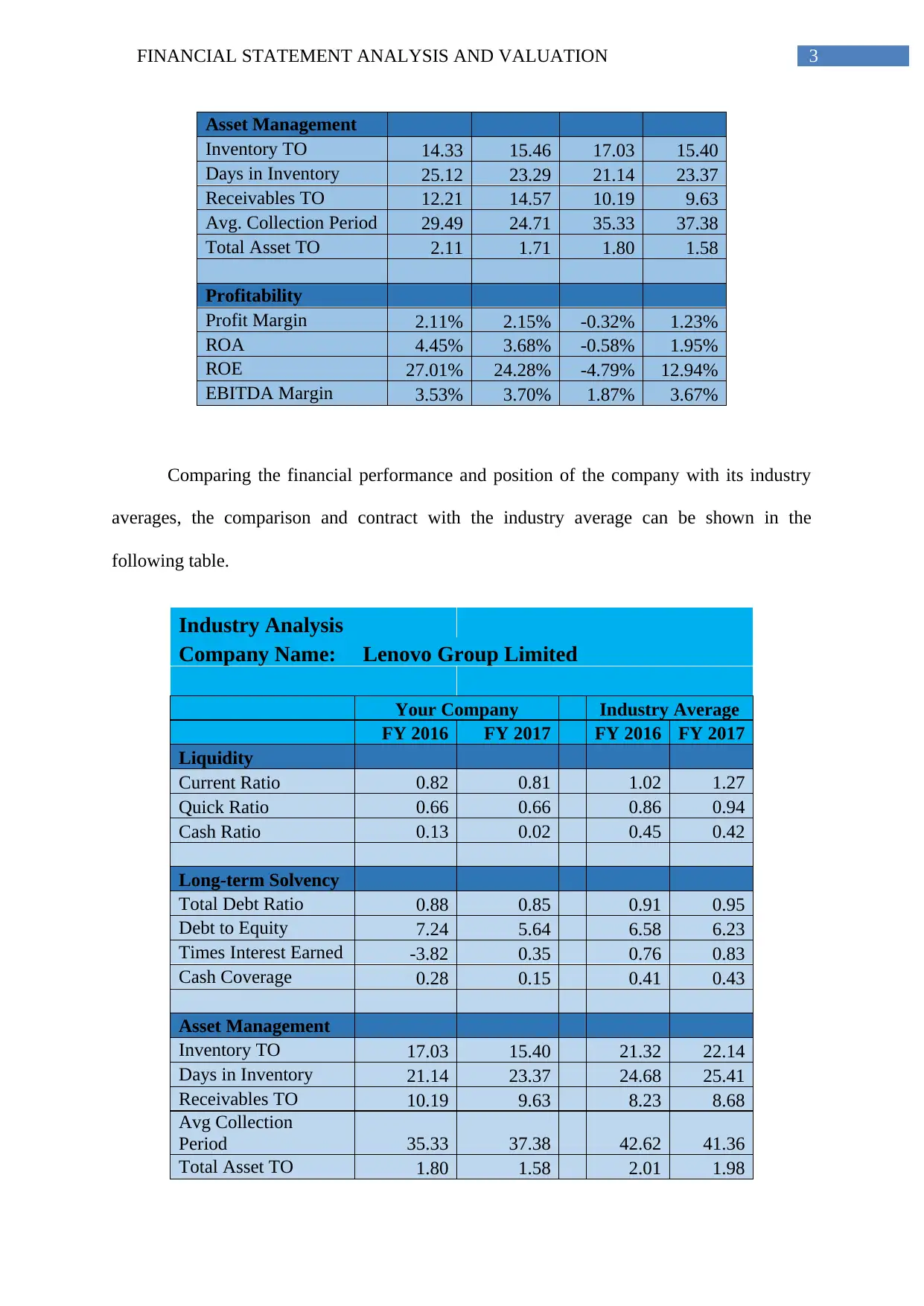
3FINANCIAL STATEMENT ANALYSIS AND VALUATION
Asset Management
Inventory TO 14.33 15.46 17.03 15.40
Days in Inventory 25.12 23.29 21.14 23.37
Receivables TO 12.21 14.57 10.19 9.63
Avg. Collection Period 29.49 24.71 35.33 37.38
Total Asset TO 2.11 1.71 1.80 1.58
Profitability
Profit Margin 2.11% 2.15% -0.32% 1.23%
ROA 4.45% 3.68% -0.58% 1.95%
ROE 27.01% 24.28% -4.79% 12.94%
EBITDA Margin 3.53% 3.70% 1.87% 3.67%
Comparing the financial performance and position of the company with its industry
averages, the comparison and contract with the industry average can be shown in the
following table.
Industry Analysis
Company Name: Lenovo Group Limited
Your Company Industry Average
FY 2016 FY 2017 FY 2016 FY 2017
Liquidity
Current Ratio 0.82 0.81 1.02 1.27
Quick Ratio 0.66 0.66 0.86 0.94
Cash Ratio 0.13 0.02 0.45 0.42
Long-term Solvency
Total Debt Ratio 0.88 0.85 0.91 0.95
Debt to Equity 7.24 5.64 6.58 6.23
Times Interest Earned -3.82 0.35 0.76 0.83
Cash Coverage 0.28 0.15 0.41 0.43
Asset Management
Inventory TO 17.03 15.40 21.32 22.14
Days in Inventory 21.14 23.37 24.68 25.41
Receivables TO 10.19 9.63 8.23 8.68
Avg Collection
Period 35.33 37.38 42.62 41.36
Total Asset TO 1.80 1.58 2.01 1.98
Asset Management
Inventory TO 14.33 15.46 17.03 15.40
Days in Inventory 25.12 23.29 21.14 23.37
Receivables TO 12.21 14.57 10.19 9.63
Avg. Collection Period 29.49 24.71 35.33 37.38
Total Asset TO 2.11 1.71 1.80 1.58
Profitability
Profit Margin 2.11% 2.15% -0.32% 1.23%
ROA 4.45% 3.68% -0.58% 1.95%
ROE 27.01% 24.28% -4.79% 12.94%
EBITDA Margin 3.53% 3.70% 1.87% 3.67%
Comparing the financial performance and position of the company with its industry
averages, the comparison and contract with the industry average can be shown in the
following table.
Industry Analysis
Company Name: Lenovo Group Limited
Your Company Industry Average
FY 2016 FY 2017 FY 2016 FY 2017
Liquidity
Current Ratio 0.82 0.81 1.02 1.27
Quick Ratio 0.66 0.66 0.86 0.94
Cash Ratio 0.13 0.02 0.45 0.42
Long-term Solvency
Total Debt Ratio 0.88 0.85 0.91 0.95
Debt to Equity 7.24 5.64 6.58 6.23
Times Interest Earned -3.82 0.35 0.76 0.83
Cash Coverage 0.28 0.15 0.41 0.43
Asset Management
Inventory TO 17.03 15.40 21.32 22.14
Days in Inventory 21.14 23.37 24.68 25.41
Receivables TO 10.19 9.63 8.23 8.68
Avg Collection
Period 35.33 37.38 42.62 41.36
Total Asset TO 1.80 1.58 2.01 1.98
Paraphrase This Document
Need a fresh take? Get an instant paraphrase of this document with our AI Paraphraser
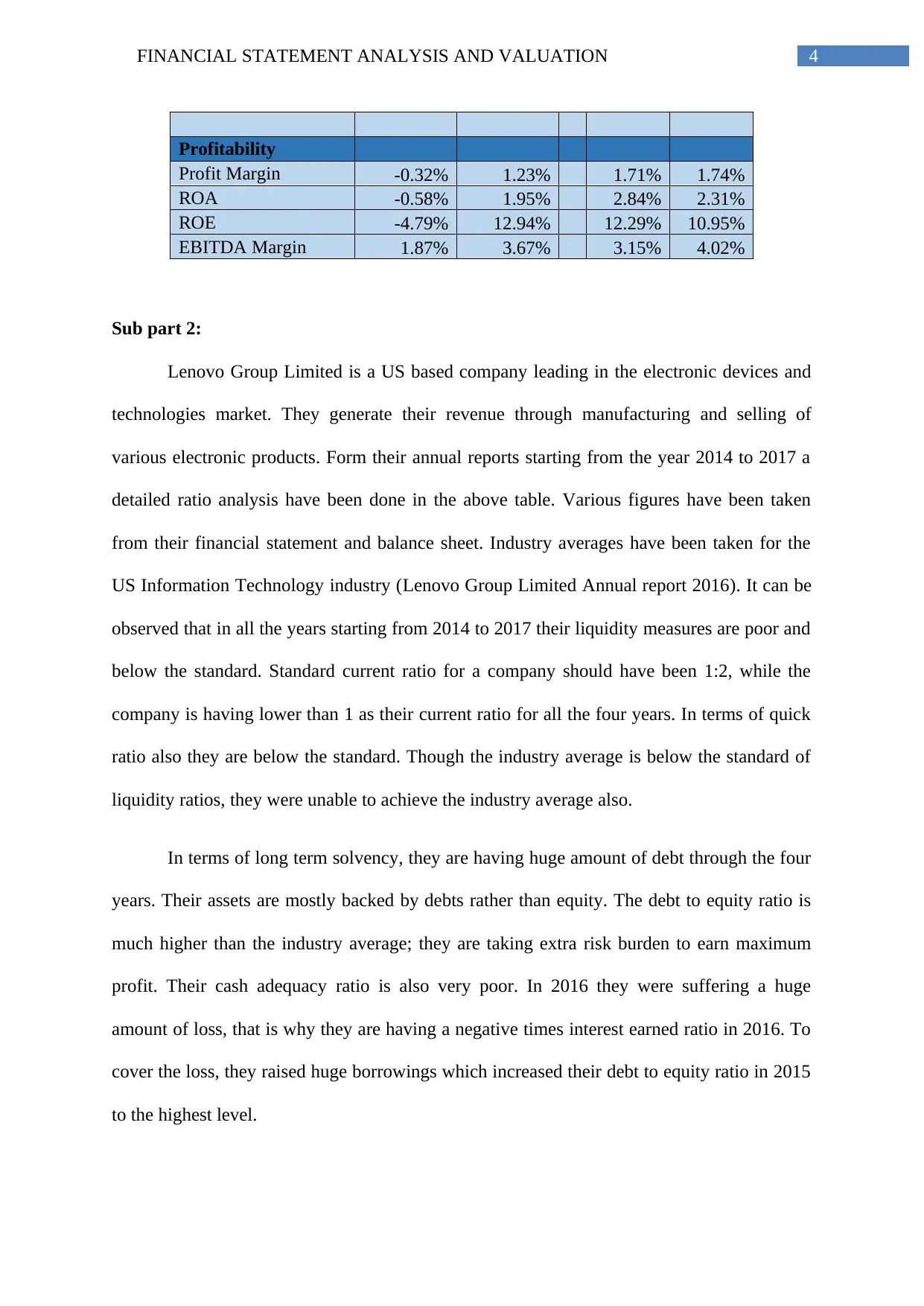
4FINANCIAL STATEMENT ANALYSIS AND VALUATION
Profitability
Profit Margin -0.32% 1.23% 1.71% 1.74%
ROA -0.58% 1.95% 2.84% 2.31%
ROE -4.79% 12.94% 12.29% 10.95%
EBITDA Margin 1.87% 3.67% 3.15% 4.02%
Sub part 2:
Lenovo Group Limited is a US based company leading in the electronic devices and
technologies market. They generate their revenue through manufacturing and selling of
various electronic products. Form their annual reports starting from the year 2014 to 2017 a
detailed ratio analysis have been done in the above table. Various figures have been taken
from their financial statement and balance sheet. Industry averages have been taken for the
US Information Technology industry (Lenovo Group Limited Annual report 2016). It can be
observed that in all the years starting from 2014 to 2017 their liquidity measures are poor and
below the standard. Standard current ratio for a company should have been 1:2, while the
company is having lower than 1 as their current ratio for all the four years. In terms of quick
ratio also they are below the standard. Though the industry average is below the standard of
liquidity ratios, they were unable to achieve the industry average also.
In terms of long term solvency, they are having huge amount of debt through the four
years. Their assets are mostly backed by debts rather than equity. The debt to equity ratio is
much higher than the industry average; they are taking extra risk burden to earn maximum
profit. Their cash adequacy ratio is also very poor. In 2016 they were suffering a huge
amount of loss, that is why they are having a negative times interest earned ratio in 2016. To
cover the loss, they raised huge borrowings which increased their debt to equity ratio in 2015
to the highest level.
Profitability
Profit Margin -0.32% 1.23% 1.71% 1.74%
ROA -0.58% 1.95% 2.84% 2.31%
ROE -4.79% 12.94% 12.29% 10.95%
EBITDA Margin 1.87% 3.67% 3.15% 4.02%
Sub part 2:
Lenovo Group Limited is a US based company leading in the electronic devices and
technologies market. They generate their revenue through manufacturing and selling of
various electronic products. Form their annual reports starting from the year 2014 to 2017 a
detailed ratio analysis have been done in the above table. Various figures have been taken
from their financial statement and balance sheet. Industry averages have been taken for the
US Information Technology industry (Lenovo Group Limited Annual report 2016). It can be
observed that in all the years starting from 2014 to 2017 their liquidity measures are poor and
below the standard. Standard current ratio for a company should have been 1:2, while the
company is having lower than 1 as their current ratio for all the four years. In terms of quick
ratio also they are below the standard. Though the industry average is below the standard of
liquidity ratios, they were unable to achieve the industry average also.
In terms of long term solvency, they are having huge amount of debt through the four
years. Their assets are mostly backed by debts rather than equity. The debt to equity ratio is
much higher than the industry average; they are taking extra risk burden to earn maximum
profit. Their cash adequacy ratio is also very poor. In 2016 they were suffering a huge
amount of loss, that is why they are having a negative times interest earned ratio in 2016. To
cover the loss, they raised huge borrowings which increased their debt to equity ratio in 2015
to the highest level.
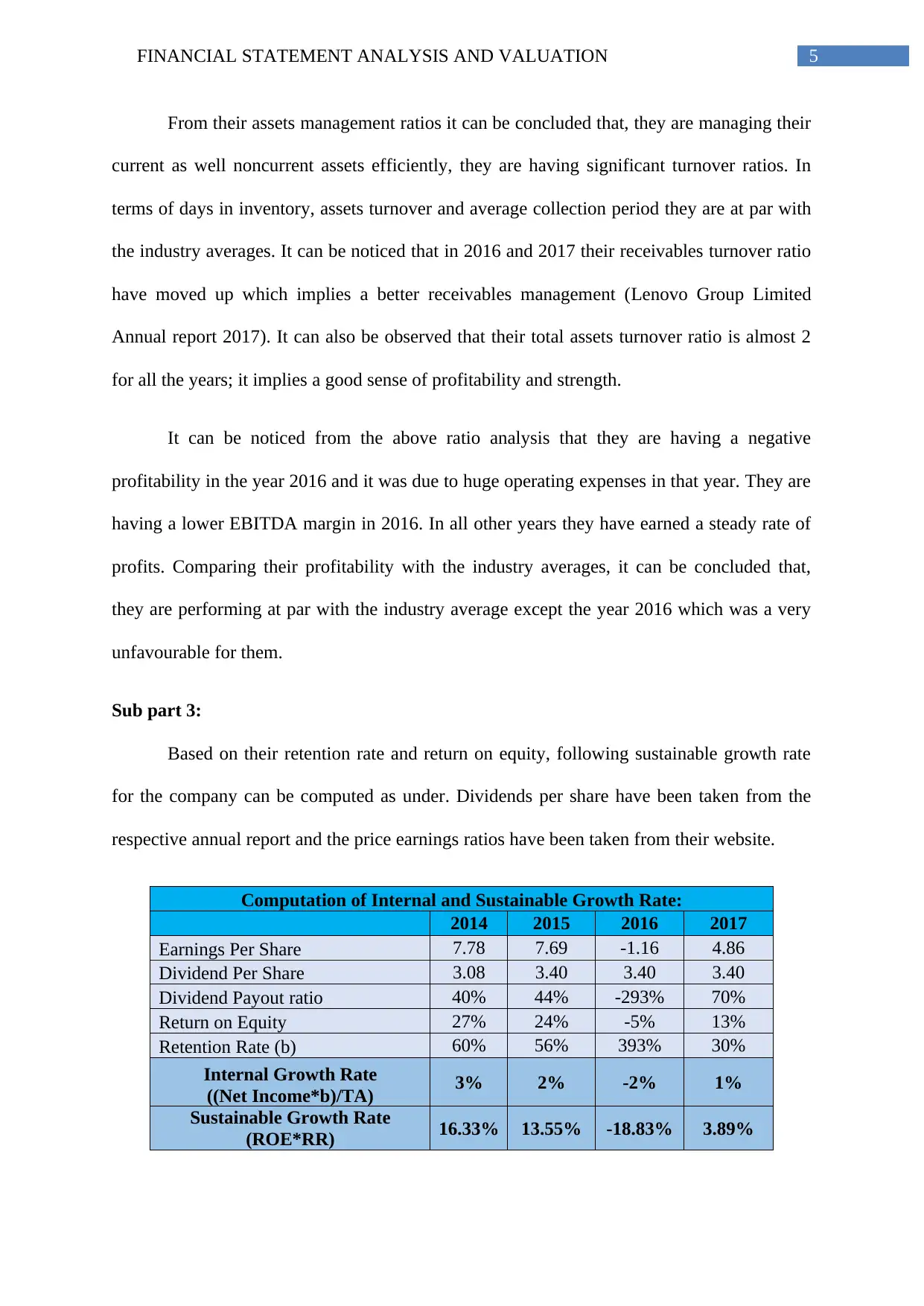
5FINANCIAL STATEMENT ANALYSIS AND VALUATION
From their assets management ratios it can be concluded that, they are managing their
current as well noncurrent assets efficiently, they are having significant turnover ratios. In
terms of days in inventory, assets turnover and average collection period they are at par with
the industry averages. It can be noticed that in 2016 and 2017 their receivables turnover ratio
have moved up which implies a better receivables management (Lenovo Group Limited
Annual report 2017). It can also be observed that their total assets turnover ratio is almost 2
for all the years; it implies a good sense of profitability and strength.
It can be noticed from the above ratio analysis that they are having a negative
profitability in the year 2016 and it was due to huge operating expenses in that year. They are
having a lower EBITDA margin in 2016. In all other years they have earned a steady rate of
profits. Comparing their profitability with the industry averages, it can be concluded that,
they are performing at par with the industry average except the year 2016 which was a very
unfavourable for them.
Sub part 3:
Based on their retention rate and return on equity, following sustainable growth rate
for the company can be computed as under. Dividends per share have been taken from the
respective annual report and the price earnings ratios have been taken from their website.
Computation of Internal and Sustainable Growth Rate:
2014 2015 2016 2017
Earnings Per Share 7.78 7.69 -1.16 4.86
Dividend Per Share 3.08 3.40 3.40 3.40
Dividend Payout ratio 40% 44% -293% 70%
Return on Equity 27% 24% -5% 13%
Retention Rate (b) 60% 56% 393% 30%
Internal Growth Rate
((Net Income*b)/TA) 3% 2% -2% 1%
Sustainable Growth Rate
(ROE*RR) 16.33% 13.55% -18.83% 3.89%
From their assets management ratios it can be concluded that, they are managing their
current as well noncurrent assets efficiently, they are having significant turnover ratios. In
terms of days in inventory, assets turnover and average collection period they are at par with
the industry averages. It can be noticed that in 2016 and 2017 their receivables turnover ratio
have moved up which implies a better receivables management (Lenovo Group Limited
Annual report 2017). It can also be observed that their total assets turnover ratio is almost 2
for all the years; it implies a good sense of profitability and strength.
It can be noticed from the above ratio analysis that they are having a negative
profitability in the year 2016 and it was due to huge operating expenses in that year. They are
having a lower EBITDA margin in 2016. In all other years they have earned a steady rate of
profits. Comparing their profitability with the industry averages, it can be concluded that,
they are performing at par with the industry average except the year 2016 which was a very
unfavourable for them.
Sub part 3:
Based on their retention rate and return on equity, following sustainable growth rate
for the company can be computed as under. Dividends per share have been taken from the
respective annual report and the price earnings ratios have been taken from their website.
Computation of Internal and Sustainable Growth Rate:
2014 2015 2016 2017
Earnings Per Share 7.78 7.69 -1.16 4.86
Dividend Per Share 3.08 3.40 3.40 3.40
Dividend Payout ratio 40% 44% -293% 70%
Return on Equity 27% 24% -5% 13%
Retention Rate (b) 60% 56% 393% 30%
Internal Growth Rate
((Net Income*b)/TA) 3% 2% -2% 1%
Sustainable Growth Rate
(ROE*RR) 16.33% 13.55% -18.83% 3.89%
⊘ This is a preview!⊘
Do you want full access?
Subscribe today to unlock all pages.

Trusted by 1+ million students worldwide
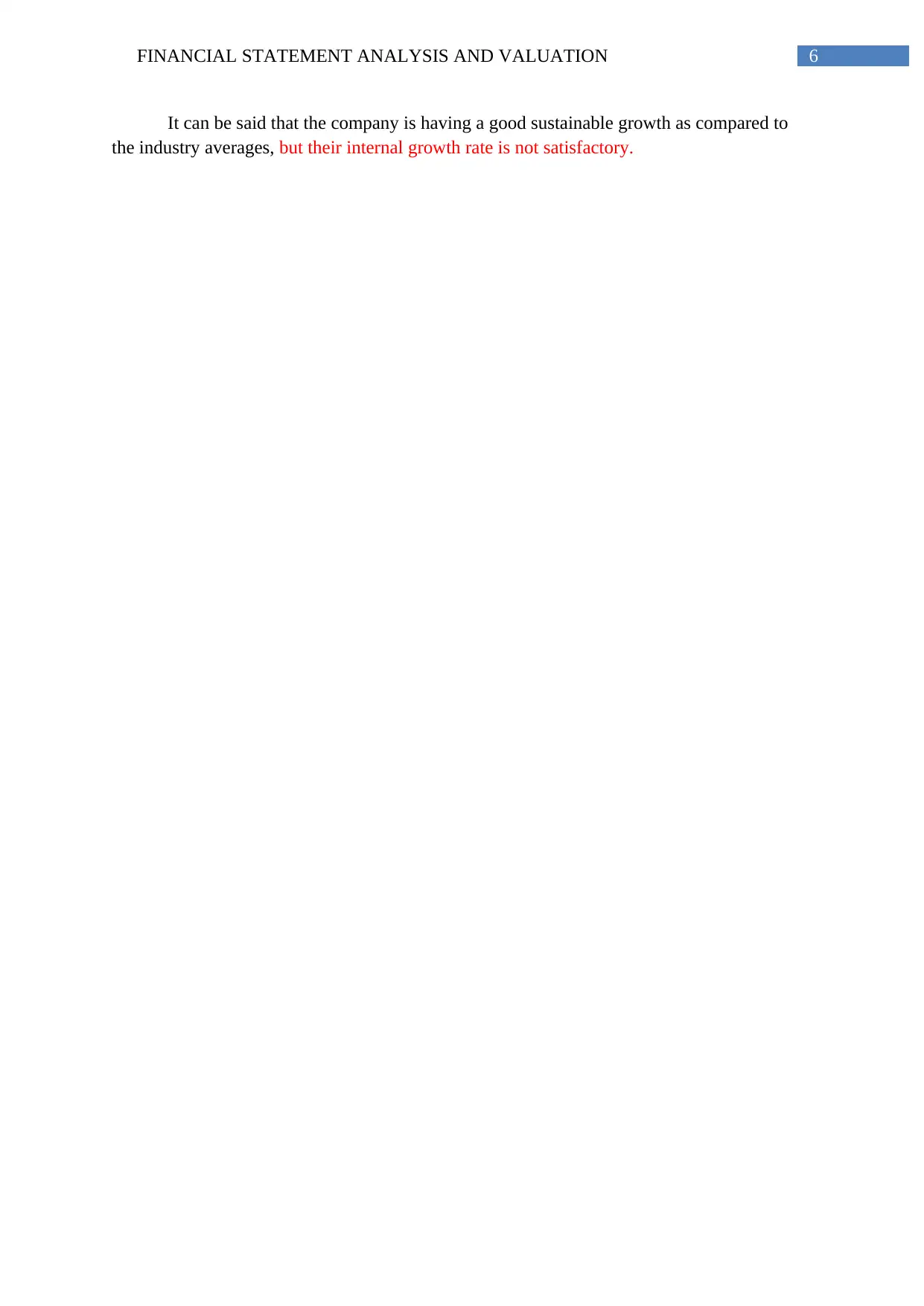
6FINANCIAL STATEMENT ANALYSIS AND VALUATION
It can be said that the company is having a good sustainable growth as compared to
the industry averages, but their internal growth rate is not satisfactory.
It can be said that the company is having a good sustainable growth as compared to
the industry averages, but their internal growth rate is not satisfactory.
Paraphrase This Document
Need a fresh take? Get an instant paraphrase of this document with our AI Paraphraser
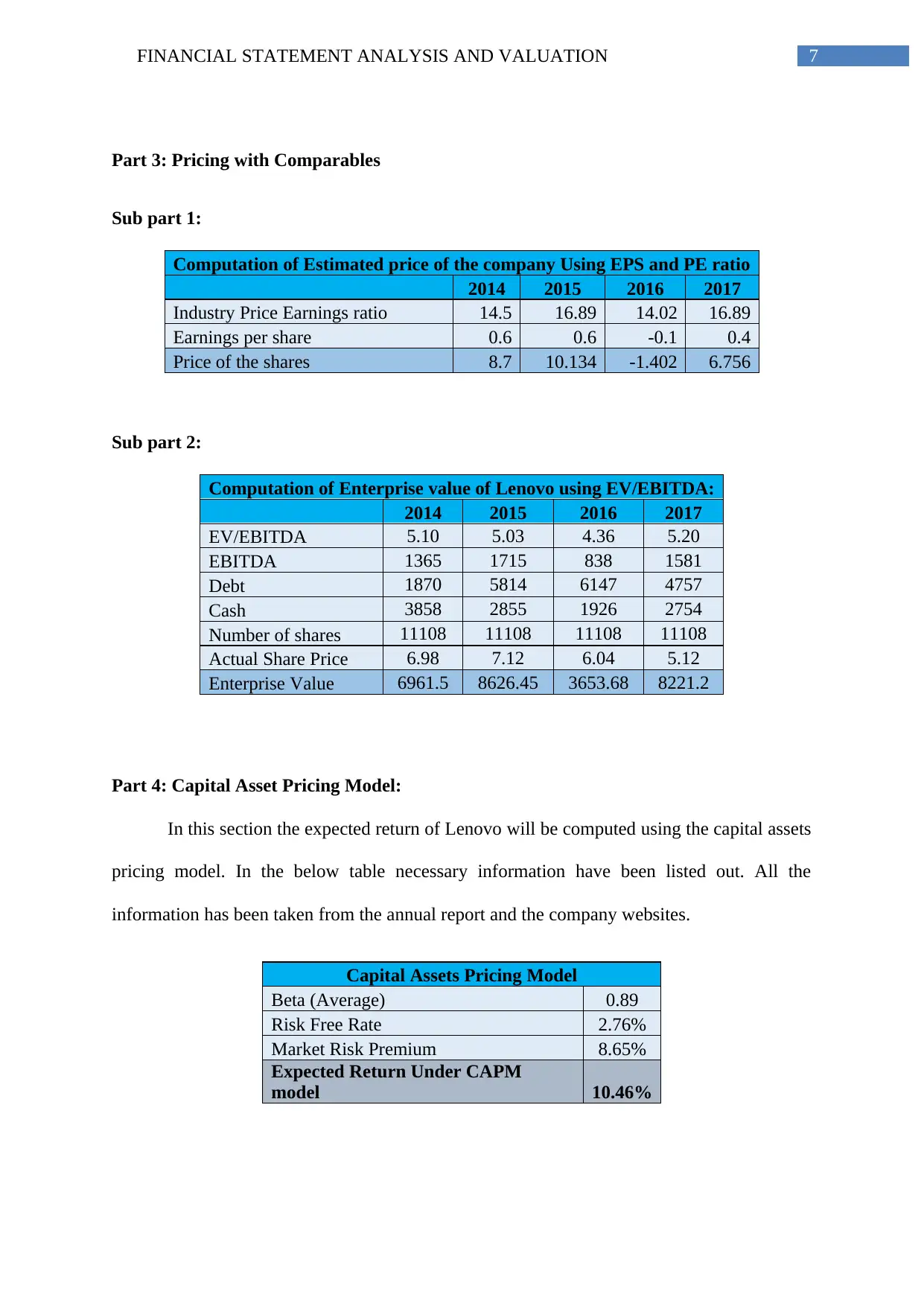
7FINANCIAL STATEMENT ANALYSIS AND VALUATION
Part 3: Pricing with Comparables
Sub part 1:
Computation of Estimated price of the company Using EPS and PE ratio
2014 2015 2016 2017
Industry Price Earnings ratio 14.5 16.89 14.02 16.89
Earnings per share 0.6 0.6 -0.1 0.4
Price of the shares 8.7 10.134 -1.402 6.756
Sub part 2:
Computation of Enterprise value of Lenovo using EV/EBITDA:
2014 2015 2016 2017
EV/EBITDA 5.10 5.03 4.36 5.20
EBITDA 1365 1715 838 1581
Debt 1870 5814 6147 4757
Cash 3858 2855 1926 2754
Number of shares 11108 11108 11108 11108
Actual Share Price 6.98 7.12 6.04 5.12
Enterprise Value 6961.5 8626.45 3653.68 8221.2
Part 4: Capital Asset Pricing Model:
In this section the expected return of Lenovo will be computed using the capital assets
pricing model. In the below table necessary information have been listed out. All the
information has been taken from the annual report and the company websites.
Capital Assets Pricing Model
Beta (Average) 0.89
Risk Free Rate 2.76%
Market Risk Premium 8.65%
Expected Return Under CAPM
model 10.46%
Part 3: Pricing with Comparables
Sub part 1:
Computation of Estimated price of the company Using EPS and PE ratio
2014 2015 2016 2017
Industry Price Earnings ratio 14.5 16.89 14.02 16.89
Earnings per share 0.6 0.6 -0.1 0.4
Price of the shares 8.7 10.134 -1.402 6.756
Sub part 2:
Computation of Enterprise value of Lenovo using EV/EBITDA:
2014 2015 2016 2017
EV/EBITDA 5.10 5.03 4.36 5.20
EBITDA 1365 1715 838 1581
Debt 1870 5814 6147 4757
Cash 3858 2855 1926 2754
Number of shares 11108 11108 11108 11108
Actual Share Price 6.98 7.12 6.04 5.12
Enterprise Value 6961.5 8626.45 3653.68 8221.2
Part 4: Capital Asset Pricing Model:
In this section the expected return of Lenovo will be computed using the capital assets
pricing model. In the below table necessary information have been listed out. All the
information has been taken from the annual report and the company websites.
Capital Assets Pricing Model
Beta (Average) 0.89
Risk Free Rate 2.76%
Market Risk Premium 8.65%
Expected Return Under CAPM
model 10.46%
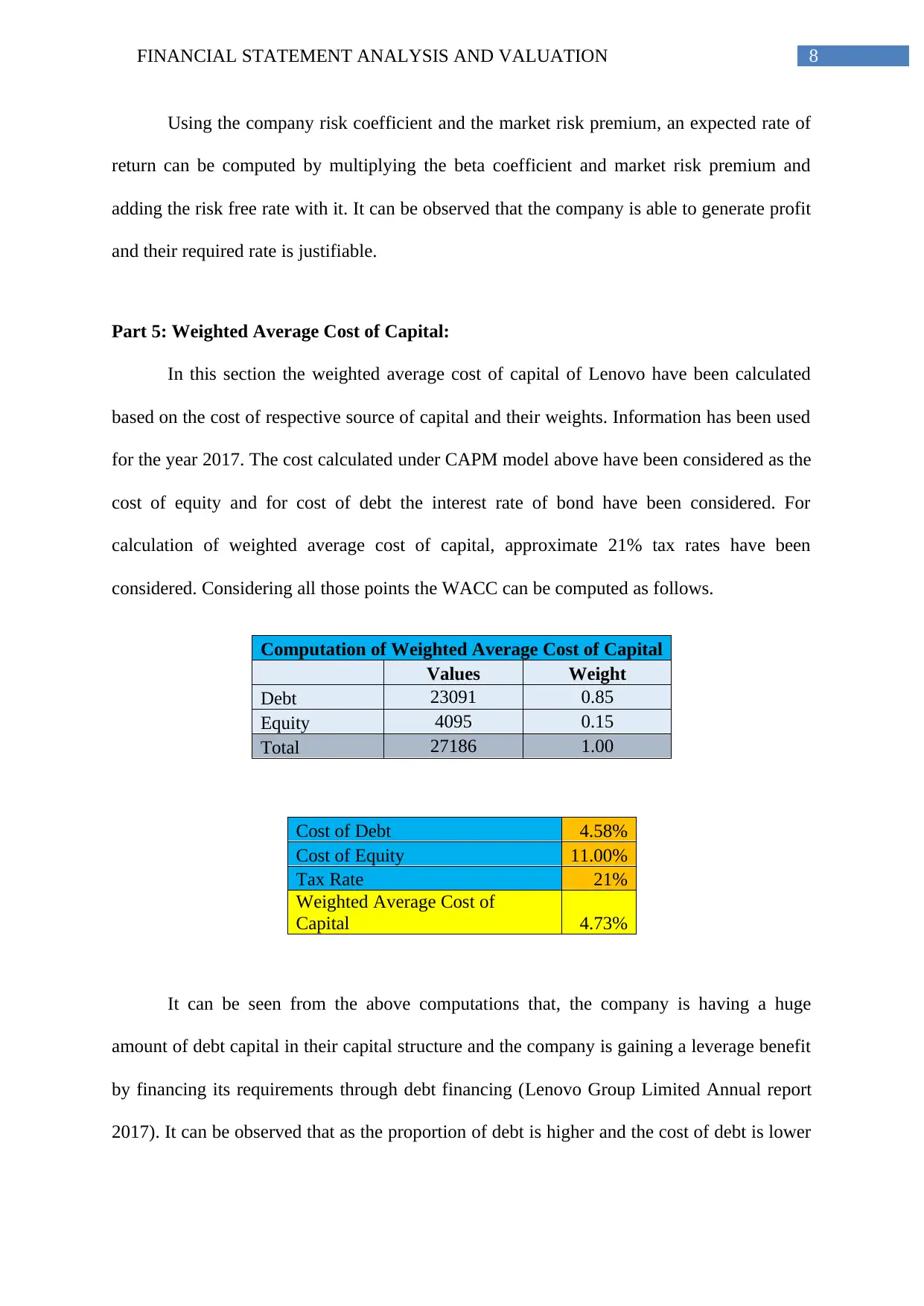
8FINANCIAL STATEMENT ANALYSIS AND VALUATION
Using the company risk coefficient and the market risk premium, an expected rate of
return can be computed by multiplying the beta coefficient and market risk premium and
adding the risk free rate with it. It can be observed that the company is able to generate profit
and their required rate is justifiable.
Part 5: Weighted Average Cost of Capital:
In this section the weighted average cost of capital of Lenovo have been calculated
based on the cost of respective source of capital and their weights. Information has been used
for the year 2017. The cost calculated under CAPM model above have been considered as the
cost of equity and for cost of debt the interest rate of bond have been considered. For
calculation of weighted average cost of capital, approximate 21% tax rates have been
considered. Considering all those points the WACC can be computed as follows.
Computation of Weighted Average Cost of Capital
Values Weight
Debt 23091 0.85
Equity 4095 0.15
Total 27186 1.00
Cost of Debt 4.58%
Cost of Equity 11.00%
Tax Rate 21%
Weighted Average Cost of
Capital 4.73%
It can be seen from the above computations that, the company is having a huge
amount of debt capital in their capital structure and the company is gaining a leverage benefit
by financing its requirements through debt financing (Lenovo Group Limited Annual report
2017). It can be observed that as the proportion of debt is higher and the cost of debt is lower
Using the company risk coefficient and the market risk premium, an expected rate of
return can be computed by multiplying the beta coefficient and market risk premium and
adding the risk free rate with it. It can be observed that the company is able to generate profit
and their required rate is justifiable.
Part 5: Weighted Average Cost of Capital:
In this section the weighted average cost of capital of Lenovo have been calculated
based on the cost of respective source of capital and their weights. Information has been used
for the year 2017. The cost calculated under CAPM model above have been considered as the
cost of equity and for cost of debt the interest rate of bond have been considered. For
calculation of weighted average cost of capital, approximate 21% tax rates have been
considered. Considering all those points the WACC can be computed as follows.
Computation of Weighted Average Cost of Capital
Values Weight
Debt 23091 0.85
Equity 4095 0.15
Total 27186 1.00
Cost of Debt 4.58%
Cost of Equity 11.00%
Tax Rate 21%
Weighted Average Cost of
Capital 4.73%
It can be seen from the above computations that, the company is having a huge
amount of debt capital in their capital structure and the company is gaining a leverage benefit
by financing its requirements through debt financing (Lenovo Group Limited Annual report
2017). It can be observed that as the proportion of debt is higher and the cost of debt is lower
⊘ This is a preview!⊘
Do you want full access?
Subscribe today to unlock all pages.

Trusted by 1+ million students worldwide
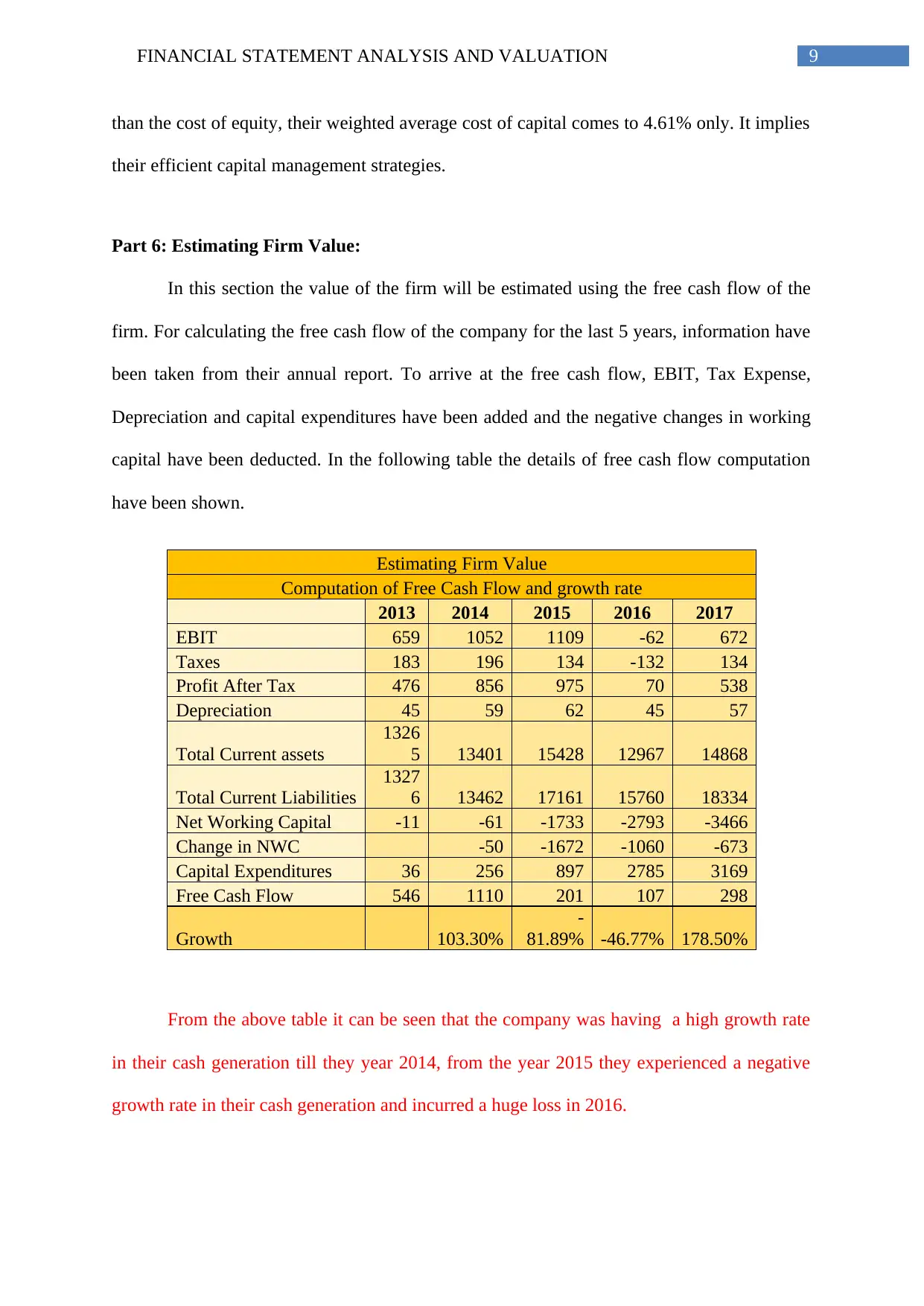
9FINANCIAL STATEMENT ANALYSIS AND VALUATION
than the cost of equity, their weighted average cost of capital comes to 4.61% only. It implies
their efficient capital management strategies.
Part 6: Estimating Firm Value:
In this section the value of the firm will be estimated using the free cash flow of the
firm. For calculating the free cash flow of the company for the last 5 years, information have
been taken from their annual report. To arrive at the free cash flow, EBIT, Tax Expense,
Depreciation and capital expenditures have been added and the negative changes in working
capital have been deducted. In the following table the details of free cash flow computation
have been shown.
Estimating Firm Value
Computation of Free Cash Flow and growth rate
2013 2014 2015 2016 2017
EBIT 659 1052 1109 -62 672
Taxes 183 196 134 -132 134
Profit After Tax 476 856 975 70 538
Depreciation 45 59 62 45 57
Total Current assets
1326
5 13401 15428 12967 14868
Total Current Liabilities
1327
6 13462 17161 15760 18334
Net Working Capital -11 -61 -1733 -2793 -3466
Change in NWC -50 -1672 -1060 -673
Capital Expenditures 36 256 897 2785 3169
Free Cash Flow 546 1110 201 107 298
Growth 103.30%
-
81.89% -46.77% 178.50%
From the above table it can be seen that the company was having a high growth rate
in their cash generation till they year 2014, from the year 2015 they experienced a negative
growth rate in their cash generation and incurred a huge loss in 2016.
than the cost of equity, their weighted average cost of capital comes to 4.61% only. It implies
their efficient capital management strategies.
Part 6: Estimating Firm Value:
In this section the value of the firm will be estimated using the free cash flow of the
firm. For calculating the free cash flow of the company for the last 5 years, information have
been taken from their annual report. To arrive at the free cash flow, EBIT, Tax Expense,
Depreciation and capital expenditures have been added and the negative changes in working
capital have been deducted. In the following table the details of free cash flow computation
have been shown.
Estimating Firm Value
Computation of Free Cash Flow and growth rate
2013 2014 2015 2016 2017
EBIT 659 1052 1109 -62 672
Taxes 183 196 134 -132 134
Profit After Tax 476 856 975 70 538
Depreciation 45 59 62 45 57
Total Current assets
1326
5 13401 15428 12967 14868
Total Current Liabilities
1327
6 13462 17161 15760 18334
Net Working Capital -11 -61 -1733 -2793 -3466
Change in NWC -50 -1672 -1060 -673
Capital Expenditures 36 256 897 2785 3169
Free Cash Flow 546 1110 201 107 298
Growth 103.30%
-
81.89% -46.77% 178.50%
From the above table it can be seen that the company was having a high growth rate
in their cash generation till they year 2014, from the year 2015 they experienced a negative
growth rate in their cash generation and incurred a huge loss in 2016.
Paraphrase This Document
Need a fresh take? Get an instant paraphrase of this document with our AI Paraphraser
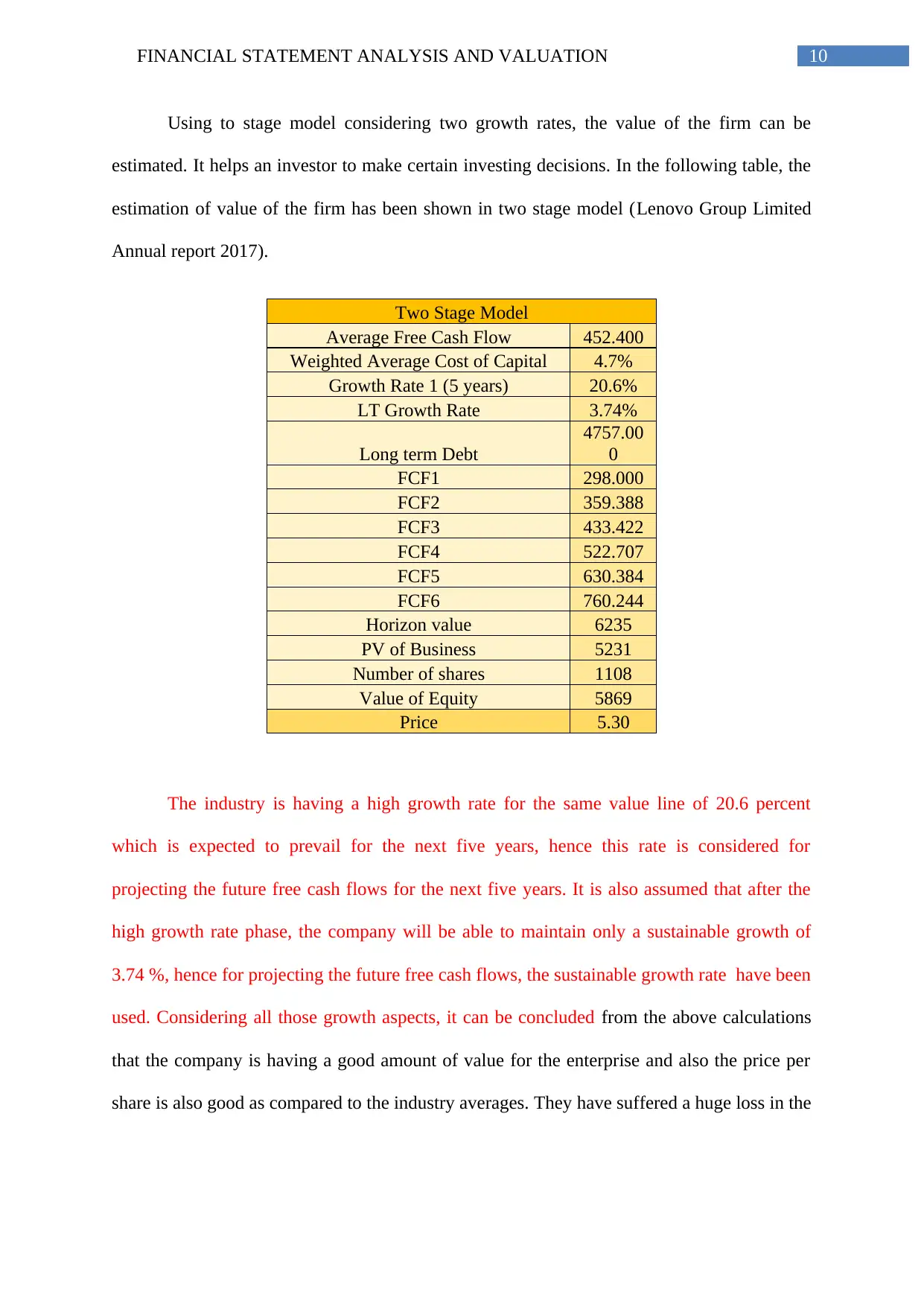
10FINANCIAL STATEMENT ANALYSIS AND VALUATION
Using to stage model considering two growth rates, the value of the firm can be
estimated. It helps an investor to make certain investing decisions. In the following table, the
estimation of value of the firm has been shown in two stage model (Lenovo Group Limited
Annual report 2017).
Two Stage Model
Average Free Cash Flow 452.400
Weighted Average Cost of Capital 4.7%
Growth Rate 1 (5 years) 20.6%
LT Growth Rate 3.74%
Long term Debt
4757.00
0
FCF1 298.000
FCF2 359.388
FCF3 433.422
FCF4 522.707
FCF5 630.384
FCF6 760.244
Horizon value 6235
PV of Business 5231
Number of shares 1108
Value of Equity 5869
Price 5.30
The industry is having a high growth rate for the same value line of 20.6 percent
which is expected to prevail for the next five years, hence this rate is considered for
projecting the future free cash flows for the next five years. It is also assumed that after the
high growth rate phase, the company will be able to maintain only a sustainable growth of
3.74 %, hence for projecting the future free cash flows, the sustainable growth rate have been
used. Considering all those growth aspects, it can be concluded from the above calculations
that the company is having a good amount of value for the enterprise and also the price per
share is also good as compared to the industry averages. They have suffered a huge loss in the
Using to stage model considering two growth rates, the value of the firm can be
estimated. It helps an investor to make certain investing decisions. In the following table, the
estimation of value of the firm has been shown in two stage model (Lenovo Group Limited
Annual report 2017).
Two Stage Model
Average Free Cash Flow 452.400
Weighted Average Cost of Capital 4.7%
Growth Rate 1 (5 years) 20.6%
LT Growth Rate 3.74%
Long term Debt
4757.00
0
FCF1 298.000
FCF2 359.388
FCF3 433.422
FCF4 522.707
FCF5 630.384
FCF6 760.244
Horizon value 6235
PV of Business 5231
Number of shares 1108
Value of Equity 5869
Price 5.30
The industry is having a high growth rate for the same value line of 20.6 percent
which is expected to prevail for the next five years, hence this rate is considered for
projecting the future free cash flows for the next five years. It is also assumed that after the
high growth rate phase, the company will be able to maintain only a sustainable growth of
3.74 %, hence for projecting the future free cash flows, the sustainable growth rate have been
used. Considering all those growth aspects, it can be concluded from the above calculations
that the company is having a good amount of value for the enterprise and also the price per
share is also good as compared to the industry averages. They have suffered a huge loss in the
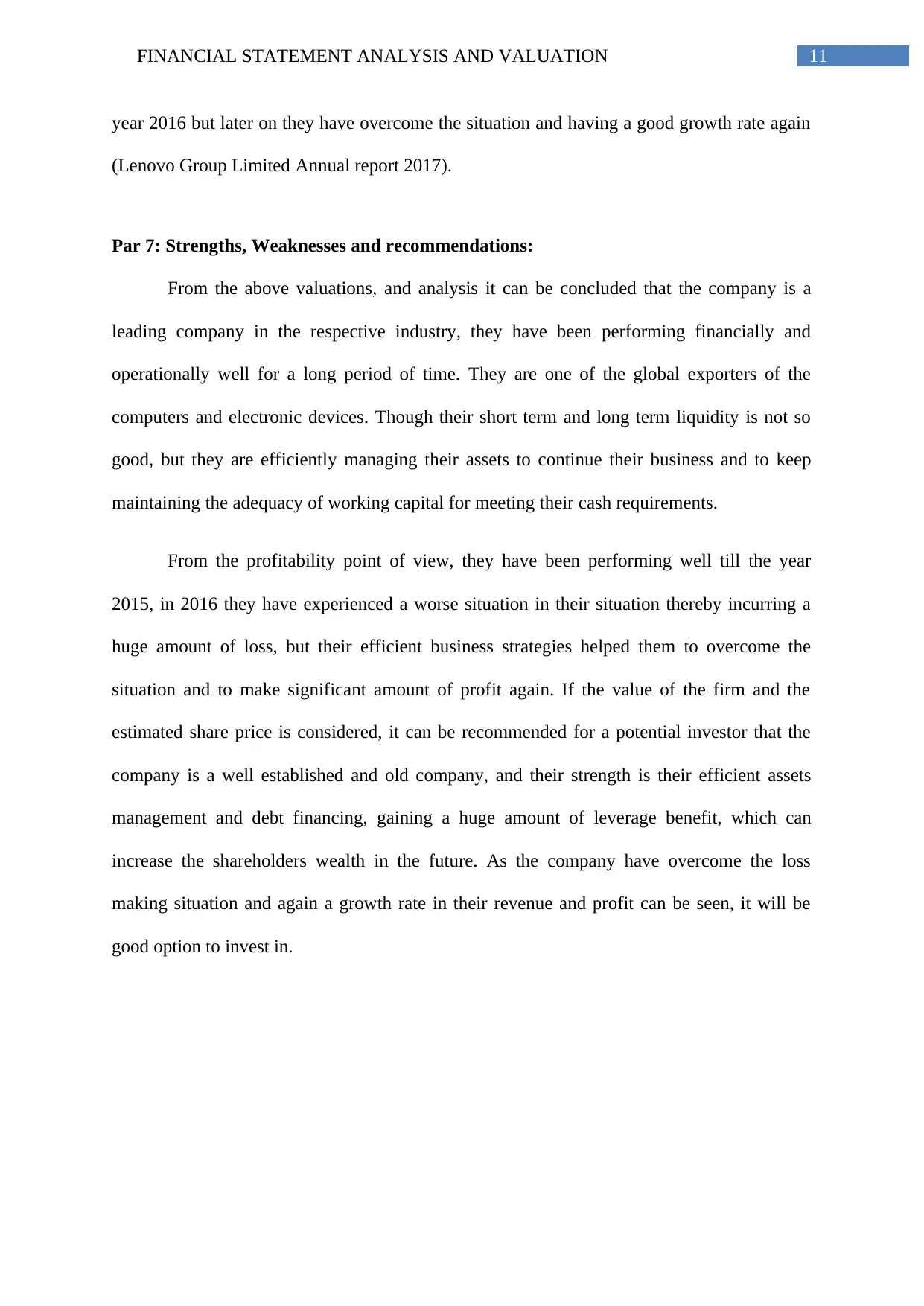
11FINANCIAL STATEMENT ANALYSIS AND VALUATION
year 2016 but later on they have overcome the situation and having a good growth rate again
(Lenovo Group Limited Annual report 2017).
Par 7: Strengths, Weaknesses and recommendations:
From the above valuations, and analysis it can be concluded that the company is a
leading company in the respective industry, they have been performing financially and
operationally well for a long period of time. They are one of the global exporters of the
computers and electronic devices. Though their short term and long term liquidity is not so
good, but they are efficiently managing their assets to continue their business and to keep
maintaining the adequacy of working capital for meeting their cash requirements.
From the profitability point of view, they have been performing well till the year
2015, in 2016 they have experienced a worse situation in their situation thereby incurring a
huge amount of loss, but their efficient business strategies helped them to overcome the
situation and to make significant amount of profit again. If the value of the firm and the
estimated share price is considered, it can be recommended for a potential investor that the
company is a well established and old company, and their strength is their efficient assets
management and debt financing, gaining a huge amount of leverage benefit, which can
increase the shareholders wealth in the future. As the company have overcome the loss
making situation and again a growth rate in their revenue and profit can be seen, it will be
good option to invest in.
year 2016 but later on they have overcome the situation and having a good growth rate again
(Lenovo Group Limited Annual report 2017).
Par 7: Strengths, Weaknesses and recommendations:
From the above valuations, and analysis it can be concluded that the company is a
leading company in the respective industry, they have been performing financially and
operationally well for a long period of time. They are one of the global exporters of the
computers and electronic devices. Though their short term and long term liquidity is not so
good, but they are efficiently managing their assets to continue their business and to keep
maintaining the adequacy of working capital for meeting their cash requirements.
From the profitability point of view, they have been performing well till the year
2015, in 2016 they have experienced a worse situation in their situation thereby incurring a
huge amount of loss, but their efficient business strategies helped them to overcome the
situation and to make significant amount of profit again. If the value of the firm and the
estimated share price is considered, it can be recommended for a potential investor that the
company is a well established and old company, and their strength is their efficient assets
management and debt financing, gaining a huge amount of leverage benefit, which can
increase the shareholders wealth in the future. As the company have overcome the loss
making situation and again a growth rate in their revenue and profit can be seen, it will be
good option to invest in.
⊘ This is a preview!⊘
Do you want full access?
Subscribe today to unlock all pages.

Trusted by 1+ million students worldwide
1 out of 14
Your All-in-One AI-Powered Toolkit for Academic Success.
+13062052269
info@desklib.com
Available 24*7 on WhatsApp / Email
![[object Object]](/_next/static/media/star-bottom.7253800d.svg)
Unlock your academic potential
Copyright © 2020–2025 A2Z Services. All Rights Reserved. Developed and managed by ZUCOL.